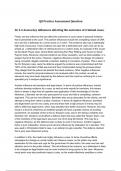Q8 Practice Assessment Question
AC 2.4 Assess key influences affecting the outcomes of criminal cases.
Firstly, one key influence that can affect the outcomes of court cases is physical evidence
that is presented to the court. The positive influences include the compelling nature of DNA
as it can link a defendant to a crime scene or a victim. This evidence also has a statistically
high level of accuracy. Trace evidence can also link a defendant and victim, this can be as
simple as a defendant's fibre of clothing found on a victim's body. An example of this would
be the Sarah Payne case, where fibres stemming from Roy Whiting were found on Sarah
Payne's body. Moreover, physical evidence can show causation, such as blood splatter, or a
weapon found at the scene. However, negative influences include, the danger of evidence
being corrupted, illegally collected or planted, leading to corruption of justice. This is seen in
the OJ Simpson case, were the defence argued the evidence was compromised and that
100% of the real killer's DNA was lost and then contaminated during the process phase.
They alleged that the police had planted the blood evidence. Other negative influences
include, the need for physical evidence to be analysed within the context, as well as
relevance may have been disputed by the defence and this could be confusing for a non -
specialist jury to analyse significance.
Another influence are barristers and legal teams. In terms of positive influences, trained
solicitors develop evidence for a case, as well as write reports for barristers, this means
there is always a high level of expertise and application of their knowledge on the law.
Moreover, a barrister can be very persuasive for a jury and hold a compelling, coherent
argument. This can be very effective. Barristers also act as advocates for the clients, and will
attempt to bring their client to justice. However, in terms of negative influences, barristers
and legal teams can be very costly, and only those with a high amount of money may be
able to afford top legal teams, which may possibly have better outcomes. However, this may
result in a level of unfainress as wealthier people will have a greater chance of avoiding
punishment, An example of this is the OJ Simpson case, due to him being a celebrity and
therefore rich, Simpson could afford a defence team that was called the 'Dream Team', one
of the members of his legal team was even one of his long life friends. This may be a
negative influence, as this defence team is likely to work in his favour. Another negative
factor is juror infatuation, where jurors become influenced by infatuation for a barrister. This
was used in Christopher Alder's case, in an attempt to gain acquittal. The defence claimed
that a juror was influenced unduly.
In addition to this, the media can highly influence a case. In terms of positive effects,
campaigns for change on social media can influence cases, as the public may raise
awareness for the case and urge for the government to take action, the case now has vast
attention and is in the public interest. This will influence the outcome, as a defendant is likely
to be charged as legal bodies may be more inclined to bring justice to this case. Moreover,
moral panic may also positively impact a case, as the media effectively amplifyes a crime




